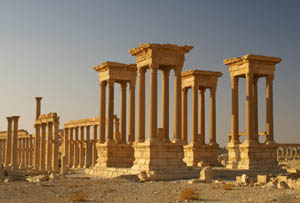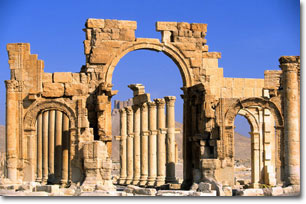Ex-Travel-Ganzer, Welcome to Syiria, beautifull country in middle east ( i’m not talking about what happen to this country right now, that not my business). My concern is there is one site thats realy beautifull here and its very useless if we not talk about it, or maybe we dont visit it. May be what people always said about “dont judge the book from the cover” its very fit for this situation. Dont judge Syria right now only because the condition is quite good right now. The important things is there is wonderfull place that can not be compared with anything.
Oke, lets travel right now, we are going to visit Palmyra, a wonderfull site in Syria. Palmyra (Tadmor in Arabic) is in the heart of Syrian Desert, and is often described as the bride of the desert. Its magnificent remains tell of a heroic history during the reign of Queen Zenobia. Beside famous as Tadmor, Palymira also famous with name Tadmur or Tudmur. This palce located 130 Miles/210 Km northeast Damascus and 180 km southwest of the Euphrates at Deir ez-Zor. It had long been a vital caravan stop for travellers crossing the Syrian desert and was known as the Bride of the Desert. The earliest documented reference to the city by its Semitic name Tadmor, Tadmur or Tudmur (which means "the town that repels" in Amorite and "the indomitable town" in Aramaic) is recorded in Babylonian tablets found in Mari.. The name Palmyra means “The City Of Palm Trees” and it was given by Roman rulers in the 1st century.
Palmyra is Syria’s most famous tourist attraction. Situated at an oasis in the desert, this ruined city is at a considerable distance from any other water source, as it is 150km from the Orontes River in the west and 200km from the Euphrates in the east. The ruins have been extensively excavated and painstakingly restored. An elusive and highly romanticized goal of travelers over the centuries, even today a visit to Palmyra is an experience, which alone makes the trip to Syria worthwhile.
Palmyra appears in the Bible (II Chronicles 8.4) as a desert city fortified by Solomon. (There is a mention of a city of Tamar in I Kings 9.18, also fortified by Solomon, which may refer to Tadmor but could also be a place near the Dead Sea.) Tadmor is also mentioned by Josephus (Antiquities, Book VIII) along with the Greek name of Palmyra, as a city built by Solomon.
The extensive ruins at Palmyra reveal the network plan of the ancient city. The Corinthian order marks almost all the monuments, but the influence of Mesopotamia and Iran is also clearly evident. The art found on monuments and tombs also reflects the influences of the surrounding Roman and Persian empires. As UNESCO puts it, "the art and architecture of Palmyra, standing at the crossroads of several civilizations, married Graeco-Roman techniques with local traditions and Persian influences." The fantastic looks and exotic views make Unesco “Build a huge wall to protect this site”. Unesco listed this site as world heritage with code 23. The reason why Unesco protected this site from the “un-controllable” civilization right now because few criterion such as shown below:
Criterion (i): The splendour of the ruins of Palmyra, rising out of the Syrian desert north-east of Damascus is testament to the unique aesthetic achievement of a wealthy caravan oasis intermittently under the rule of Rome from the Ier to the 3rd century AD. The grand colonnade constitutes a characteristic example of a type of structure which represents a major artistic development.
Criterion (ii): Recognition of the splendour of the ruins of Palmyra by travellers in the 17th and 18th centuries contributed greatly to the subsequent revival of classical architectural styles and urban design in the West.
Criterion (iv): The grand monumental colonnaded street, open in the centre with covered side passages, and subsidiary cross streets of similar design together with the major public buildings, form an outstanding illustration of architecture and urban layout at the peak of Rome's expansion in and engagement with the East. The great temple of Ba'al is considered one of the most important religious buildings of the 1st century AD in the East and of unique design. The carved sculptural treatment of the monumental archway through which the city is approached from the great temple is an outstanding example of Palmyrene art. The large scale funerary monuments outside the city walls in the area known as the Valley of the Tombs display distinctive decoration and construction methods.
The Temple of Bel on the eastern edge of the site has a huge courtyard, which is 200 metres square. The Great Colonnade lined with columns, was once the city’s main street. The Monumental Arch at one end of the colonnade has been partially restored. The Theatre, Market Place and Banqueting Hall are located on the southern side of the colonnaded street. Other buildings, such as baths and temples are scattered on either side of the main street.
Other ruins include a vast complex called Diocletian's Camp and the chief Palmyrene temple sanctuary, dedicated to Bel, Yarhibol, and Aglibol. Palmyra's museum, between the ruins and the new town, contains statues and objects excavated from the site.
The city’s museum, situated between the ruins and the new town, contains many statues and objects, which have been excavated from the site.
Outside the ancient walls, the Palmyrenes constructed a series of large-scale funerary monuments which now form the so-called Valley of the Tombs, a 1 km long necropolis, with a series of large, richly decorated structures. These tombs, some of which were below ground, had interior walls that were cut away or constructed to form burial compartments in which the deceased, extended at full length, were placed. Limestone slabs with human busts in high relief sealed the rectangular openings of the compartments.
These reliefs represented the "personality" or "soul" of the person interred and formed part of the wall decoration inside the tomb chamber. A banquet scene depicted on this relief suggests a family tomb rather than that of an individual.
Archaeological teams from various countries have worked on-and-off on different parts of the site. In May 2005, a Polish team excavating at the Lat temple discovered a highly-detailed stone statue of the winged goddess of victory Nike.
Recently, archaeologists in working in central Syria have unearthed the remnants of a 1,200-year-old church believed to be the largest ever discovered in Syria, at an excavation site in the ancient town of Palmyra. This church is the fourth to be discovered in Palmyra. Officials described it as the biggest of its kind to be found so far — its base measuring an impressive 51 by 30 yards. The church columns were estimated to be 20 feet tall, with the height of the wooden ceiling more than 49 feet. A small amphitheater was found in the church's courtyard where the experts believe some Christian rituals were practiced. In November 2010 Austrian media manager Helmut Thoma admitted to looting a Palmyrian grave, where he has stolen architectural pieces, today presented in his private living room. German and Austrian archaeologists protested against this crime.
How To Get To Palmyra.
Palmyra was an important city located in an oasis 215 km northeast of Damascus and 180 km southwest of the Euphrates at Deir ez-Zor
Syria’s airline proposed domestic flights from Damascus to Deir ez-Zur for one hour. from Deir ez-Zur you can reach Palmyra from Deir ez-Zur by taxi (three hours). Use bus or taxi services from Damascus to Palmyra (three or four hours). If you were in a car and maintained an average speed of 60mph (96 kmh) over the course of your journey it would take you around 2.3 hours to get from Palmyra to Damascus.



 10:44 PM
10:44 PM
 Unknown
Unknown








 Posted in:
Posted in: 


0 comments:
Post a Comment